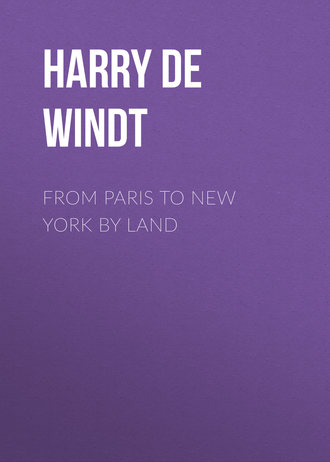 полная версия
полная версияFrom Paris to New York by Land
All things considered I cannot see what object would be gained by the construction (at present) of a Franco-American railway. That the latter will one day connect Paris and New York I have little doubt, for where gold exists the rail must surely follow, and there can be no reasonable doubt regarding the boundless wealth and ultimate prosperity of those great countries of the future; Siberia and Alaska. But it is probably safe to predict that the work will not be accomplished in the lifetime of the present generation, or even commenced during the existence of the next. When, at the conclusion of the journey, I arrived at New York, I was asked by reporters whether I considered it possible to connect the latter city by rail with Paris. Most certainly it would be possible with unlimited capital, for this stupendous engineering feat would assuredly entail an expenditure (on the Siberian side alone and not including a Bering Straits tunnel), of fifty to sixty millions sterling. It seems to me that the question is not so much, "Can the line be laid?" as "Would it pay?" In the distant future this question may perhaps be answered in the affirmative, but at present nothing whatever is known of the mineral resources of Arctic Siberia, a practical survey of which must take at least fifteen to twenty years. If reports are then favourable, Russia may begin to consider the advisability of a line to America, but, notwithstanding the fact that an attempt has been made in certain quarters to obtain money from the public for this now extremely shadowy scheme, I can only say that all the prominent Russian officials whom I have met simply ridicule the project.
Skagway is pleasantly situated on the shores of the Lynn Canal, in an amphitheatre formed by precipitous cliffs, the granite peaks of which almost overhang the little town. A curious effect is produced here by rudely coloured advertisements of some one's chewing gum, or somebody's else cigars with which the rocky sides of the nearest hills are defaced. But there is nothing new in this, for, as far back as 1887, the name of a well-known American pill and ointment vendor met my astonished gaze on the Great Wall of China. The North Pole will soon be the only virgin field left open to the up-to-date advertiser. Skagway is now a quiet, orderly township, and a favourite resort of tourists, but shortly after it was founded, in 1898, a band of swindlers and cut-throats arrived on the scene, and practically held the place at their mercy for several weeks. The leader of this gang was one "Soapy Smith," a noted "confidence man," whose deeds of violence are still spoken of here with bated breath. This impudent scoundrel (said to have been a gentleman by birth) was clever enough to become mayor of the town, and was thus enabled to commit robberies with impunity. Many a poor miner leaving the country with a hardly earned pile has been completely fleeced, and sometimes murdered, by the iniquitous and ubiquitous "Soapy," who is said to have slain, directly or indirectly, over twenty men. Finally, however, a mass meeting was held, where Smith was shot dead, not before he had also taken the life of his slayer.
Southern Alaska is the Switzerland of America, and every summer its shores are invaded by hordes of tourists. There was, therefore, little room to spare in the steamer in which we travelled down the Lynn Canal, one of the grandest fjords on the coast, which meanders through an archipelago of beautiful islands, and past a coast-line of snowy peaks and glaciers of clear, blue crystal washed by the waves of the sea. Its glaciers are one of the wonders of Alaska, for nowhere in the world can they be witnessed in such perfection. According to a talented American authoress, "In Switzerland a glacier is a vast bed of dirty, air-holed ice, that has fastened itself like a cold, porous plaster to the side of an alp. Distance alone lends enchantment to the view. In Alaska a glacier is a wonderful torrent that seems to have been suddenly frozen when about to plunge into the sea," and the comparison, although far-fetched, is not wholly devoid of truth.
Nearing Juneau we passed the Davidson glacier sufficiently near to distinguish the strange and beautiful effects produced upon its white and glittering surface by cloud and sunshine. This is the second largest ice-field in Alaska, the finest being its immediate neighbour, the Muir glacier, which drains an area of 800 square miles.91 The actual ice surface covers about 350 square miles, the mass of it, thirty-five miles long and ten to fifteen miles wide, while surrounding it on three sides are mountains averaging 4000 to 6000 ft. in height. Vessels dare not approach the ice wall, about 250 ft. high, nearer than a quarter of a mile, as masses of ice continually fall from its surface, and submarine bergs, becoming detached from its sunken fore-foot rise to the surface with tremendous force. The colour of the ice on the Muir glacier is as curious as it is beautiful, varying from the lightest blue to dark sapphire, and from a dark olive to the tenderest shades of green. Although the feat has been often attempted no one has yet succeeded in crossing the Muir from shore to shore.92
The captain of the Topeka informed me that glaciers and canneries are the chief attractions of this coast. I assumed that it could not be the climate, for rain drizzled persistently from a grey and woolly sky nearly all the way from Skagway to Port Townsend, and this was regarded as "seasonable summer weather." With bright sunshine this journey through a calm inland sea, gliding smoothly through fjords of incomparable beauty, surrounded by every luxury, would be idyllic. As it is, cold, rain and mist generally render this so-called pleasure trip one of monotony and discomfort, where passengers are often compelled to seek shelter throughout the day in smoke-room or saloon. Swathed in oil-skins, however, I braved the downpour, and visited one of the numerous canneries to which the Topeka tied up for a few minutes, and here I was surprised to find that Chinese labour is almost exclusively employed. And the ease and celerity with which a fish was received, so to speak, fresh from the sea, cleaned, steamed, and securely soldered in a smartly labelled tin, all by machinery, within the space of a few minutes, was marvellous to behold. Before the days of Klondike, the fisheries of this coast were the chief source of wealth in Alaska, where sea-board, lakes, and rivers teem with fish, the wholesale netting of which seem in no way to diminish the number. The yearly output of these coast canneries is something stupendous, and they are, undoubtedly, a far better investment than many a claim of fabulous (prospective) wealth in the gold-fields of the interior. For the establishment of a cannery is not costly, labour and taxes are low, and fish of every description, from salmon and trout to cod and halibut, can be caught without difficulty in their millions. Codfish which abound in Chatham Creek are the most profitable, also herrings, of which six hundred barrels were once caught in a single haul, off Killisnoo. But the number of canneries on this coast is increasing at a rapid rate, and five or six years hence large fortunes will be a thing of the past. The now priceless sea-otter was once abundant along the south-eastern coast of Alaska, the value of skins taken up to 1890 being thirty-six million dollars, but the wholesale slaughter of this valuable animal by the Russians, and later on by the Americans, has driven it away, and almost the only grounds where it is now found are among the Aleutian Islands and near the mouth of the Copper River. A good sea-otter skin now costs something like £200 in the European market.
Juneau and Port Wrangell were the only towns of any size touched at during the two days' trip from Skagway to Port Townsend. The former was once the fitting-out place for miners bound for the Yukon, but Skagway has now ruined its commercial prosperity, and it is now a sleepy, miserable settlement which appeared doubly unattractive viewed through a curtain of mist. The rain poured down here in such sheets that Douglas Island, only a couple of miles away, was invisible. Here is the famous Treadwell mine, where the largest quartz mill in the world crushes six hundred tons in the twenty-four hours. This mine has already yielded more gold than was paid for the whole of Alaska.
Fort Wrangell is more picturesque than Juneau, although perhaps this was partly due to the cessation (for exactly half an hour) of the rain, which enabled our hitherto cooped-up tourists to enjoy a stroll, and a breath of fresh air ashore. Wrangell was once, like Juneau, a thriving town, when the Cassiar mines in British Columbia were a centre of attraction. Between four and five thousand miners passed through every spring and autumn, travelling to and from the diggings, and the usual hotels, saloons, and stores sprang up on all sides. Then came a period of stagnation, till the last gold rush to Klondike, when it seemed as though Wrangell would rise from its ashes. But the proposed route into the country by way of the Stikine River was finally abandoned for the White Pass, and dealt the final coup de grâce to the little town, which is now merely a decaying collection of wooden shanties and ruined log huts, tenanted chiefly by Indians, of whom we met more here than at any other point throughout the Alaskan journey. The natives of this part of the coast are called Thlinkits, a race numbering about 7000, and once numerous and powerful. But the Siwashes of Wrangell were a miserable-looking lot, the men apparently physically inferior to the women, some of whom would not have been ill-favoured, had it not been for the disgusting habit of daubing their faces with a mixture of soot and grease, which is supposed to keep off mosquitoes, and which gives them the grotesque appearance of Christy Minstrels. Tattooing no longer prevails amongst the Thlinkits, but the men still paint their faces and discard ragged tweeds and bowlers for the picturesque native dress on the occasion of a dance, or the feast known as a "Potlatch." The Thlinkits are not hardy, nor, as a rule, long-lived, and diseases due to drink and dissipation are rapidly thinning them out. Shamanism exists here, but not to such an extent as amongst the Siberian races, and the totem poles, which are met with at every turn in Wrangell, are not objects of worship, but are used apparently for a heraldic purpose. Some of the ancient war canoes of this tribe are still in existence, but they are only brought out on the occasion of a feast, when a chief and his crew appear in the gaudy panoply of war-paint and feathers.
On July 28, Seattle was reached, and here we met with a reception worthy of far doughtier deeds than we had accomplished. In 1896, Seattle was a country town of some 30,000 inhabitants, and I could scarcely recognise this fine modern city of over 100,000 souls which may shortly rival San Francisco as a commercial and social centre. This wonderful change is partly due to discoveries in the Klondike, but chiefly perhaps to the increasing trade of Puget Sound with the East. Fine Japanese liners now run direct every fortnight from Seattle to Japan, and on one of these a passage was obtained for my faithful friend and comrade, Stepan Rastorguyeff, whose invaluable services I can never repay, and to whom I bade farewell with sincere regret. I am glad to add that the plucky Cossack eventually reached his home in safety (viâ Yokohama and Vladivostok) arriving in Yakutsk by way of Irkutsk and the Lena River early in the new year of 1902. Vicomte de Clinchamp also left me here, to return direct to France viâ New York and Le Havre.
There is little more to tell. Travelling leisurely in glorious weather through the garden-girt towns and smiling villages of the "Rouge-River" Valley, perhaps the most picturesque and fertile in the world, a day was passed at Shasta Springs, the summer resort of fashionable Californians, where the sun-baked traveller may rest awhile in a little oasis of coolness and gaiety, cascades and flowers, set in a desert of dark pines. A week with old friends in cosmopolitan, ever delightful San Francisco, a rapid and luxurious journey across the American continent, land on August 25, 1902, New York was reached, and the long land journey of 18,494 miles from Paris, which had taken us two-thirds of a year to accomplish, was at an end.
APPENDIX I
APPROXIMATE TABLE OF DISTANCES PARIS TO NEW YORK
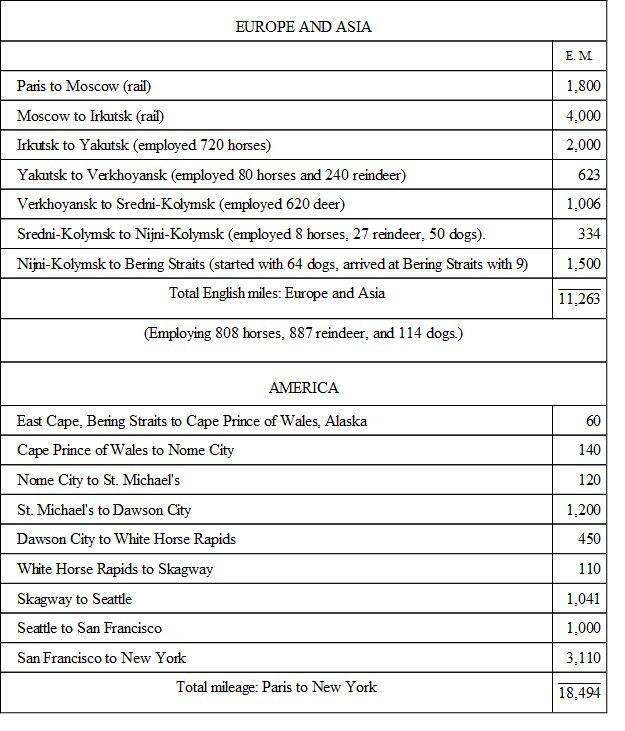
APPENDIX II
LIST OF POST-STATIONS BETWEEN IRKUTSK AND YAKUTSK

APPENDIX III
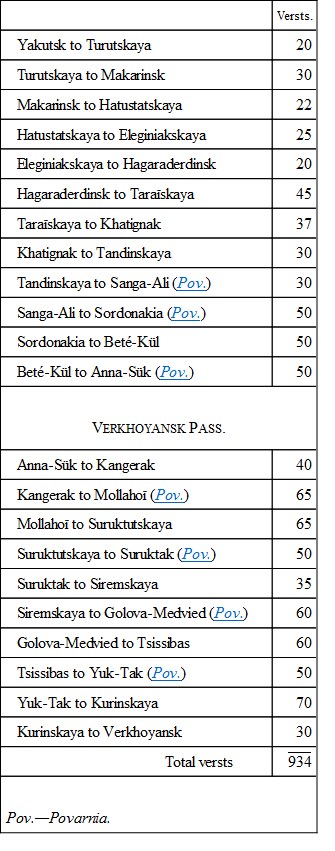
APPENDIX IV
YAKUTE SETTLEMENTS BETWEEN VERKHOYANSK AND SREDNI-KOLYMSK

APPENDIX V
SETTLEMENTS ON KOLYMA RIVER BETWEEN SREDNI-KOLYMSK AND NIJNI-KOLYMSK
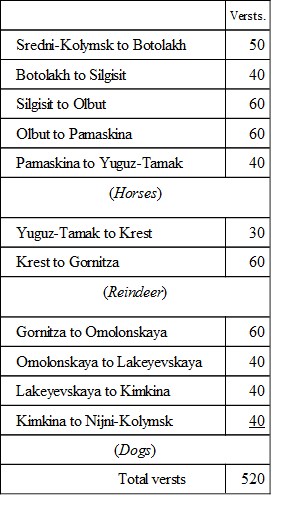
APPENDIX VI
A SHORT GLOSSARY OF YAKUTE WORDS

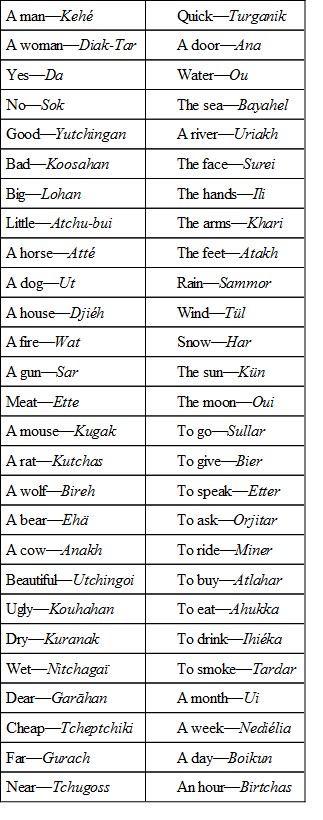
APPENDIX VII
GLOSSARY OF VARIOUS DIALECTS IN USE AMONGST THE TCHUKTCHIS INHABITING THE COASTS OF N.E. SIBERIA

APPENDIX VIII
METEOROLOGICAL RECORD OF THE DE WINDT EXPEDITION
Paris to New York, 1901-1902
[92] 40° below zero inside tent for three hours at night.
[93] Dates from this must be set back one day on account of crossing 180° long.
[94] Sea ice opened.
THE END
1
Russian whist.
2
"Lake Baikal is about twenty miles from Irkutsk. It is 420 miles in length, its breadth varying from ten to sixty miles. Its average depth is rarely less than 819 ft., but in parts the ground has been touched only at 4500 ft. The natives believe it to be unfathomable."—"Side Lights on Siberia," by J. Y. Simpson.
3
The Lena river has an estimated length of not less than 3000 miles. It rises in the Baikal mountains and flows north and east past the towns of Kirensk, Vitimsk, and Olekminsk to Yakutsk, thence it turns to the north-west and enters the Arctic Ocean, forming a wide delta. The Lena receives several large tributaries, viz., the Vitim, about 1400, the Olekma, about 800, and the Aldan, about 1300 miles long.
4
This must be very slow travelling, for Dobell, the traveller, writes: "When I descended the Lena from Ust-kutsk in the spring of 1816, I was only fourteen days going to Yakutsk in a large flat-bottomed boat."
5
"Siberia and the Exile System," by George Kennan.
6
A verst is two-thirds of an English mile.
7
I was surprised by the interest displayed by the Russian settlers of this district anent the Boer War. In every village we were eagerly questioned as to how affairs in the Transvaal were progressing.
8
Driver.
9
An official who combines the duties of Mayor and Chief of Police.
10
A "pood" is thirty-six English pounds.
11
A kopek is the one-hundredth part of a rouble; the value of the latter is about 2s. 1d.
12
This was on February 14, 1902, and 7800 miles (out of a somewhat alarming total) now lay behind us. To reach this from Irkutsk we had employed 720 horses, at a cost of under £70 for both sleighs.
13
In face of these natural resources it is satisfactory to note that a line from Irkutsk to Yakutsk could be laid with little difficulty.
14
Steam navigation on the Lena river was introduced in 1885.
15
See projected railway route, chap. xix.
16
The Port of Ola is now also called at.
17
This line is now commenced. See chap. xix.
18
The Lena is not perfectly free from ice until the end of May or early in June. By October 20 it is generally frozen over. "It is a peculiarity of these northern rivers that their waters are mainly derived from the melting snows in June and July, when the Lena, for example, overflowing its banks, spreads here and there to a width of 60 miles or more."—("In the Lena Delta," by G. W. Melville.)
19
The Russian Admiral Von Wrangell (who visited Yakutsk in 1820) wrote: "The inhabitants are not in an advanced state of intellectual cultivation. They pass much of their super-abundant leisure in somewhat noisy assemblages where eating and drinking play a principal part. After dinner, which is a very substantial meal, and at which nalivka, a liquor made of brandy, berries, and sugar, is not spared, the gentlemen pass the afternoon with cards and punch, and the ladies gather round the tea-table."
20
"In the Lena Delta," by G. W. Melville.
21
For further details of this prison see "The New Siberia," by Harry de Windt. Chatto and Windus, London. 1896.
22
The explorer Dobell wrote: "In the autumn of 1813 I found that agriculture had advanced no further than Olekma (Olekminsk), 600 versts above Yakutsk."
23
The Skoptsi faith, the practice of which is strictly forbidden in Russia, entails a life of absolute chastity. This sect can only acquire new members by election, since both sexes so mutilate their persons that they can neither beget nor bear children.
24
When a Skopt dies, his property is confiscated by the State, but he generally finds means to dispose of his wealth in other ways. Occasionally it is buried in remote places, where it remains if not discovered by accident.
25
This race is supposed to be a Turkish branch of the Turanian stock. Latham informs us that their language is intelligible at Constantinople, and that the majority of their words are Turkish; observing, also, that their traditions bespeak for them a Southern origin. He says: 'The locality of the Yakutes is remarkable, it is that of a weak section of the human race pressed into an inhospitable climate by a stronger one, yet the Turks have ever been the people to displace others rather than be displaced themselves.'"—"Frozen Asia," by Professor Eden.
26
On such occasions Christy's "Kola Chocolate" is invaluable.
27
The U.S. Arctic exploring steamer Jeannette was crushed in the ice and sank on June 12, 1881, in the Arctic Ocean, some hundreds of miles N.-E. of the mouth of the Lena river. Captain de Long and his party, in three ship's boats, made their way over and through the ice towards the Lena delta, but one of the boats (under Lieut. Chipp) foundered with all hands. Another one, commanded by Chief Engineer (now Admiral) Melville, reached the Siberian coast and found the natives and salvation, but Captain de Long and his crew landed on the Lena delta, and being unable to find a settlement or procure food, his entire party, consisting of twelve persons, perished, after horrible sufferings, of exposure and starvation. The bodies were eventually found by Melville, and conveyed to America for interment.
28
Rest-houses for convict gangs along the great post-road.
29
In 1820 Von Wrangell wrote: "During my stay in Verkhoyansk a kind of epidemic catarrhal fever prevailed throughout the district; the symptoms were violent depression of the chest, noise in the ears, headache, etc.... A Cossack whom I had previously sent forward with my papers died of the epidemic; every one was more or less ill."
30
The telegraph wire ceases at Yakutsk.
31
"Siberia and the Exile System," by George Kennan.
32
Petty officials.
33
No wonder Zashiversk figures to this day on most English maps, when it is shown on an official map of the Russian General Staff published as late as 1883!
34
"Carnyl" (invented by Dr. Yorke-Davies) is a patent food I can heartily recommend to Arctic explorers, as it is not only sustaining but very palatable.
35
The Tunguses number about 12,000 to 15,000, and inhabit the region lying to the north-west and north-east of Yakutsk.
36
"Through Siberia," by J. Stadling. London, 1901.
37
When the letter "u" is surmounted by two dots it is pronounced like that in "Curtain."
38
The names of places between Verkhoyansk and Sredni-Kolymsk were furnished by Stepan Rastorguyeff.
39
The now obsolete town of Zashiversk was situated on the right bank of this river.
40
Political prisoners are no longer confined in the fortress of SS. Peter and Paul. Short terms of imprisonment previous to banishment to Siberia are served in the citadels of Warsaw and other cities, but Schlüsselburg and Akatui are the only establishments now used as political prisons in the real sense of the word.
41
I was requested to suppress the name.
42
The Russian explorer, Von Wrangell, mentions an apparently similar mental disease as existing in these regions in 1820. He writes: "There is here, indeed (Sredni-Kolymsk), as in all Northern Siberia, that singular malady called mirak, which, according to the universal superstition of the people, proceeds from the ghost of a much-dreaded sorceress, which is supposed to enter into and torment the patient. The mirak appears to me to be only an extreme degree of hysteria; the persons attacked are chiefly women."—"Siberia and the Polar Sea," by Von Wrangell, 1829.
43
Russian: Narodna-Volya.
44
I was told that the majority of the suicides amongst the exiles here occur towards the end of their term of banishment, a fact which seemed incredible until I learned that sentences are frequently prolonged for an indefinite period, just at the time when the exile is expecting release. The suspense and uncertainty attending the last months of captivity are thus a frequent cause of self-destruction, especially amongst women and the younger men.
45
Only suicides are buried in this plot of ground, which contains over a score of graves.
46
A political exile escaping to the United States can become (in ten years) an American citizen.
47
The River Kolyma, like the Indigirka, has its source in the Stanovoi Mountains.
48
"Sredni" signifies "Middle," and "Nijni" "Lower" Kolymsk, according to their situations on the Kolyma River.

